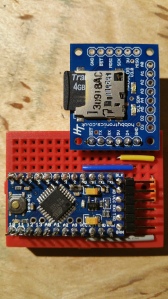Hobbytronics ArduLogger V3 and Arduino pro mini circuit…
I’ve got a nice simple working circuit for my ArduLogger V3 board. Re-jigged it just now to minimise the number of wires. Image below for your edification:-
Remember too, when using a solderable breadboard (from SparkFun) of the same size, the logging sd card board will rotate 180 degrees, and sit below the breadboard rather than sticking out. A nice compact logging circuit.
I’ve got some test software that simulates logging GPX (XML) format GPS based track information to the SD card every couple of seconds. Sample SD card append code is available on my GitHub page.
Connect the FTDI to the pins (on the right of the breadboard, above) to your computer, and you’re away!
BE AWARE: When programming the board, remove the ArduLogger breakout from the circuit, else it interferes with serial communication to the Arduino pro mini. Once reprogrammed, disconnect the FTDI cable, add the ArduLogger back in, then reconnect the FTDI (to power the circuit). Alternatively power the breadboard directly.
Note on wires above:-
- Blue wire links ground on the logger to the Arduino
- yellow, orange, and grey wires take a circuitous route to link 5V with VCC on the Arduino
- The position of the logger board next to the Arduino automatically lines up and connects TX and RX pins (and RST)
The sharp eyed among you may have noticed the Arduini is a 3.3V 8MHz variant, whereas the power pin on the logger says 5V. You can run 3.3V through here quite happily.
Note that as previously mentioned, the ArduLogger board and the open logger software only works with Hardware Serial – software serial WILL NOT work. You have been warned.

Recent Comments